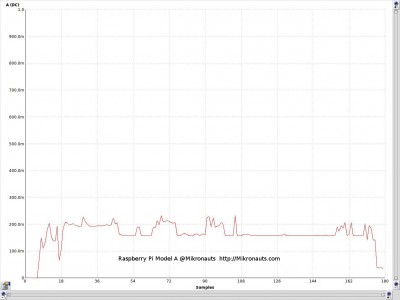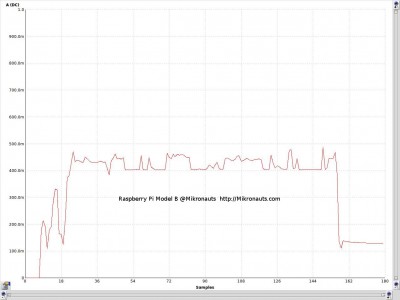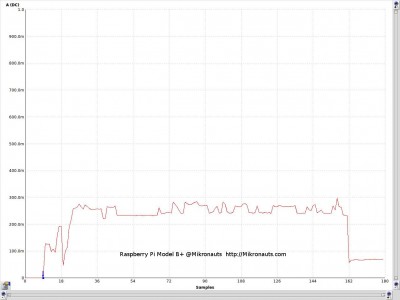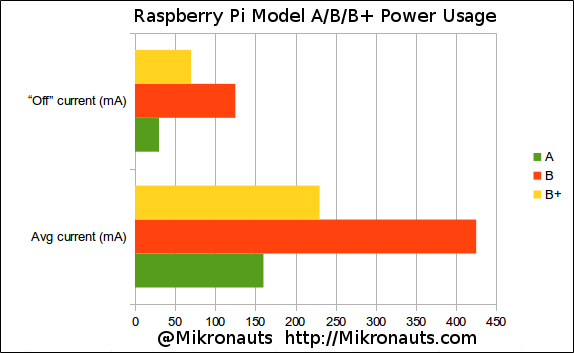Raspberry Pi Model B+ Review
Power Consumption Comparison of Model A/B/B+
A few pages ago, I talked about the improved switching power regulation of the new model B+
I just had to see for myself… and I was pretty sure that you, my readers, would also be interested.
Test Setup
- Samsung 2A 5V charger
- ADATA Permium 16GB Class 10 microSD card
- BYTECC KVM-4UHM
- Microsoft Wireless Keyboard/Mouse 800
- Samsung 27″ 1080p monitor
- Cat 5e 100Mbps Ethernet connection
- Raspberry Pi rev.2 Model A
- Raspberry Pi rev.2 Model B
- Raspberry Pi v1.2 Model B+
I made a small breakout board to tap into the +5V from the power supply, and used my data logging multimeter to measure the current consumption.
I used the same SD card for each test.
For each test:
- I started with the power disconnected
- Powered on the Pi being tested
- After booting to a text console, I typed “startx”
- After the desktop was up, I ran Midori from the start menu
- After Midori was fully up, I used the desktop to shut the Pi down.
Raspberry Pi Model A Power Test
(Click for larger image. Raspberry Pi Model A Power Usage)
I was impressed with the low power consumption of the Model A. If a single USB port and 256MB of memory is enough for your application, the Model A just sips power at an average consumption of 160mA for this test.
A large part of the power savings is due to not having a LAN9512 Ethernet chip and associated electronics on board.
Unfortunately the Model A still sips 30mA after it is turned off via software.
Raspberry Pi Model B Power Test
(Click for larger image. Raspberry Pi Model B Power Usage)
The Model B came in around 425mA average power consumption, and it still drew a fairly hefty 125mA after it was turned off.
Raspberry Pi Model B+ Power Test
(Click for larger image. Raspberry Pi Model B+ Power Usage)
Color me impressed!
| Model | A | B | B+ |
| Avg current (mA) | 160 | 425 | 230 |
| “Off” current (mA) | 30 | 125 | 70 |
The new Model B+ came in with an average power consumption of only 230mA – just over half the power consumption of the Model B!
Unfortunately we still have a pesky 70mA being drawn after the Pi “turns off”.
Conclusion
What I liked about the new Raspberry Pi Model B+
- better power supply
- four USB ports
- 5 more available I/O
- micro SD
- four mounting holes
- 99% software compatibility (1% off for no P5 I/O’s)
- good hardware compatibility
What I did not like about the Raspberry Pi Model B+
- the full schematic is not available
- amount of current used when the Pi is “turned off”
- loss of GPIO formerly on P5
“You had me at four USB ports!”
The four USB ports, combined with the improved power system, eliminates the need for an external powered hub for the vast majority of applications, and the reduction in power usage leads to greatly improved run times when running on batteries. The other changes are nice as well 🙂
Not releasing full schematics may not matter to a large segment of buyers, but it limits what advanced users as well as software and hardware designers can do with the new Model B+. There is no valid reason for not releasing the schematics – the Broadcomm chip can only be purchased in vast volumes, and any “clones” using a different processor would not really be clones as they could not run all Pi software. I am hoping that the Raspberry Pi Foundation will release the full schematics soon.
As a highly technical user, I am looking forward to faster, multi core Raspberry Pi’s of the future, but I can certainly understand the need to control costs for the target market – education.
If I had to give the Raspberry Pi Model B+ a numeric rating, I’d rate the new Rasberry Pi Model B+ at 95% – or as I said at the start, “Almost Perfect”.
Well done!
Related Links
- Raspberry Pi Foundation official Raspberry Pi Model B+ blog posting
- Large high resolution photo of the Raspberry Pi Model B at the Foundation
- Mechanical Drawing at the Raspberry Pi Foundation
- Model B+ 40 Pin GPIO pinout at the Raspberry Pi Foundation



